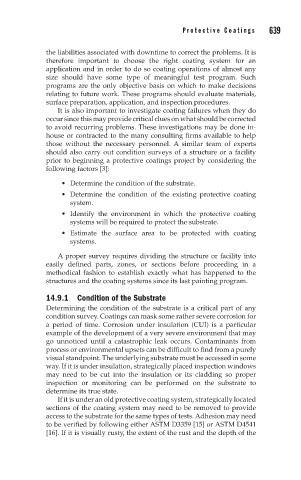Page 685 - Corrosion Engineering Principles and Practice
P. 685
638 C h a p t e r 1 4 P r o t e c t i v e C o a t i n g s 639
the liabilities associated with downtime to correct the problems. It is
therefore important to choose the right coating system for an
application and in order to do so coating operations of almost any
size should have some type of meaningful test program. Such
programs are the only objective basis on which to make decisions
relating to future work. These programs should evaluate materials,
surface preparation, application, and inspection procedures.
It is also important to investigate coating failures when they do
occur since this may provide critical clues on what should be corrected
to avoid recurring problems. These investigations may be done in-
house or contracted to the many consulting firms available to help
those without the necessary personnel. A similar team of experts
should also carry out condition surveys of a structure or a facility
prior to beginning a protective coatings project by considering the
following factors [3]:
• Determine the condition of the substrate.
• Determine the condition of the existing protective coating
system.
• Identify the environment in which the protective coating
systems will be required to protect the substrate.
• Estimate the surface area to be protected with coating
systems.
A proper survey requires dividing the structure or facility into
easily defined parts, zones, or sections before proceeding in a
methodical fashion to establish exactly what has happened to the
structures and the coating systems since its last painting program.
14.9.1 Condition of the Substrate
Determining the condition of the substrate is a critical part of any
condition survey. Coatings can mask some rather severe corrosion for
a period of time. Corrosion under insulation (CUI) is a particular
example of the development of a very severe environment that may
go unnoticed until a catastrophic leak occurs. Contaminants from
process or environmental upsets can be difficult to find from a purely
visual standpoint. The underlying substrate must be accessed in some
way. If it is under insulation, strategically placed inspection windows
may need to be cut into the insulation or its cladding so proper
inspection or monitoring can be performed on the substrate to
determine its true state.
If it is under an old protective coating system, strategically located
sections of the coating system may need to be removed to provide
access to the substrate for the same types of tests. Adhesion may need
to be verified by following either ASTM D3359 [15] or ASTM D4541
[16]. If it is visually rusty, the extent of the rust and the depth of the

